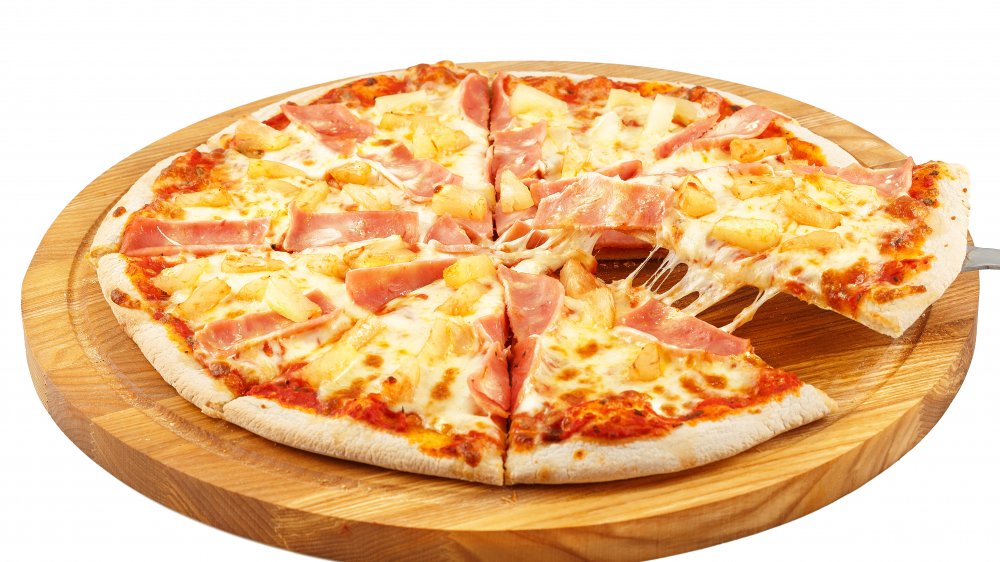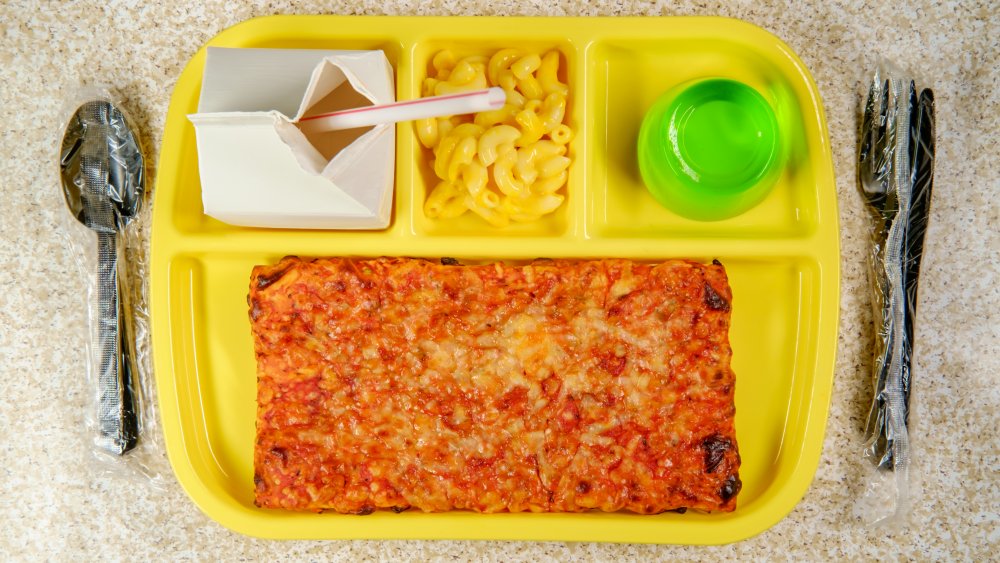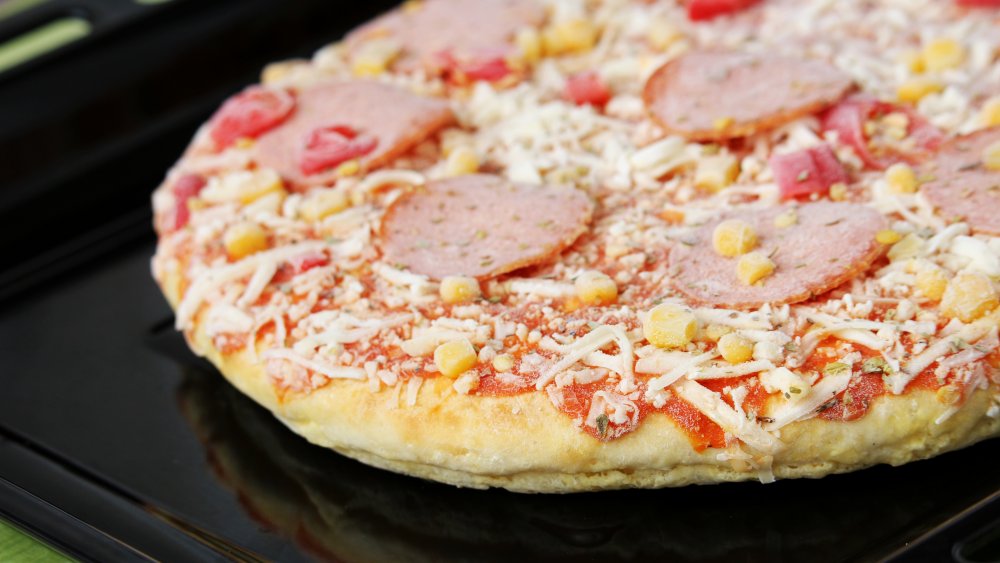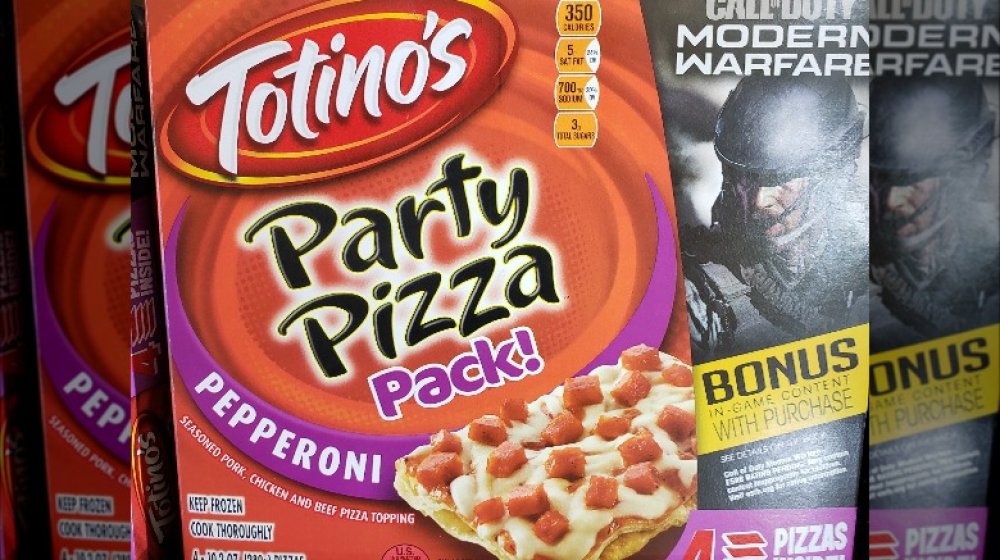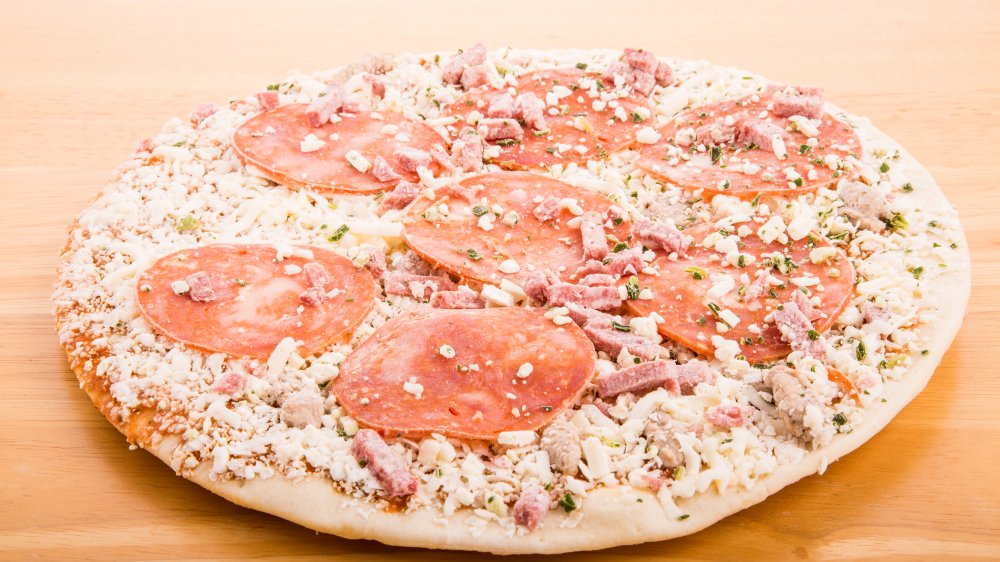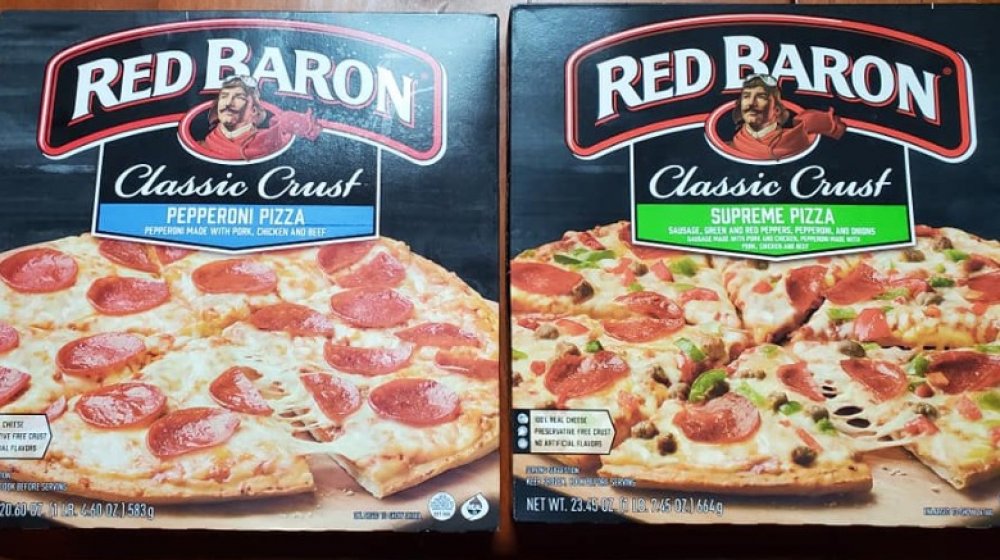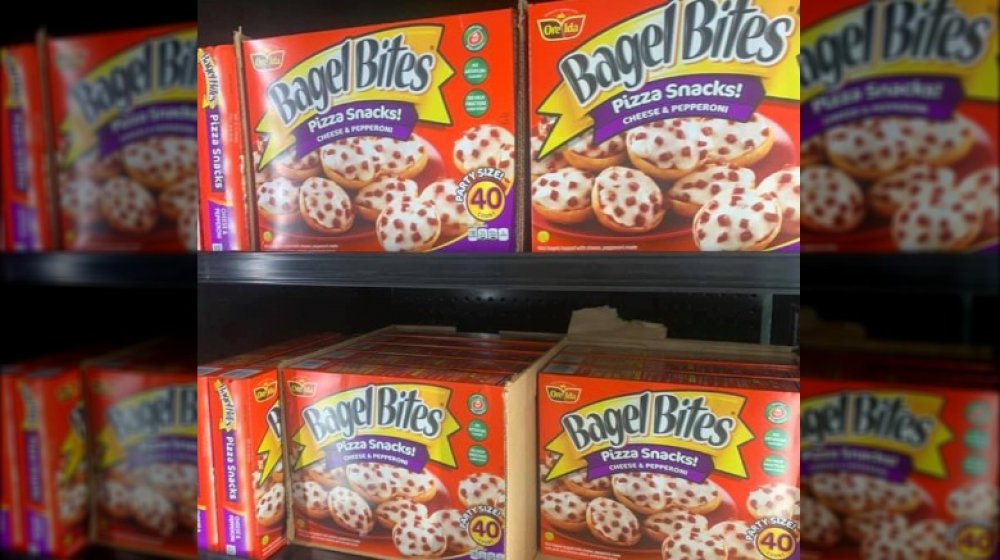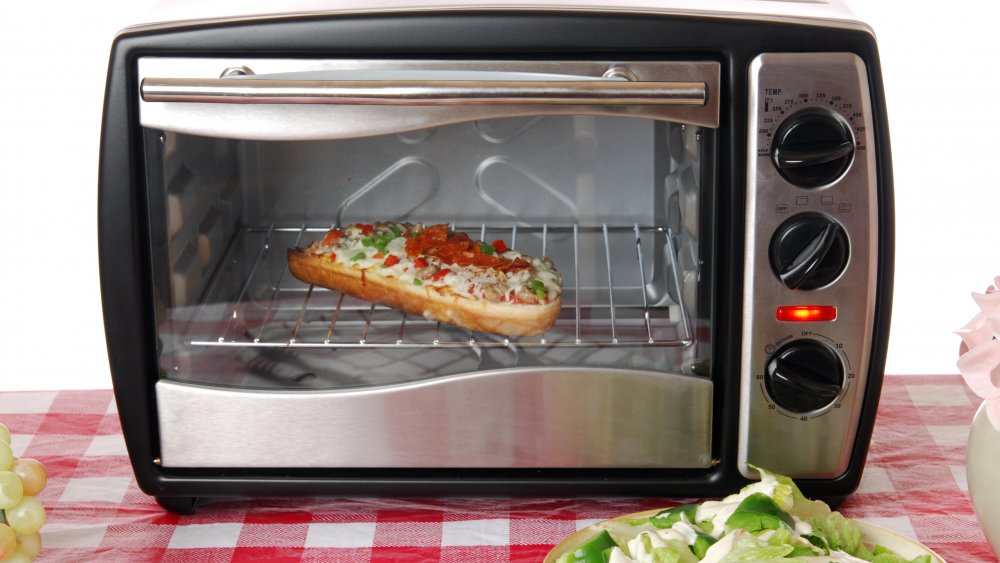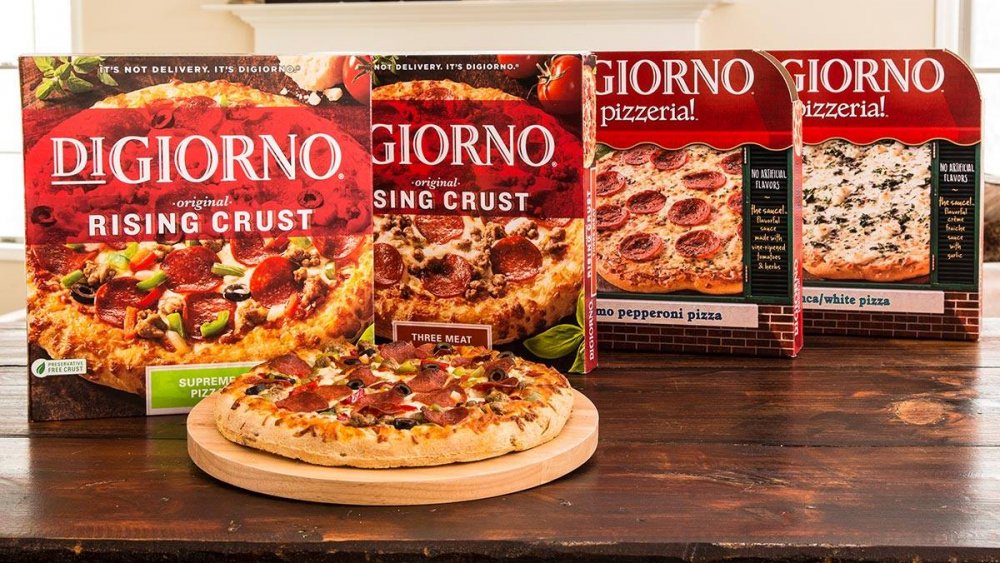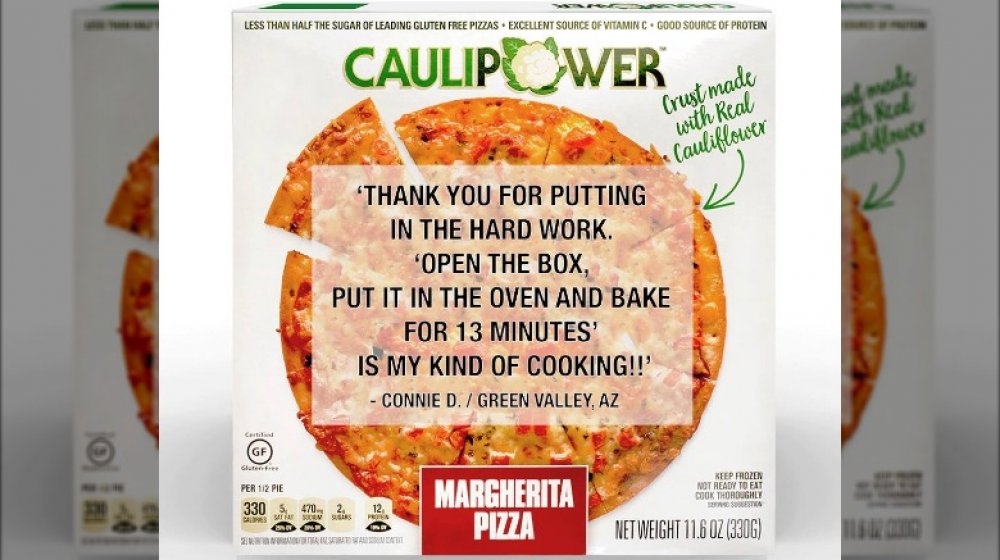The Untold Truth Of Frozen Pizzas
For the modern American family, frozen pizza is like manna from heaven on the average weekday night. It's fast, it's easy, it takes practically no planning or preparation (except for preheating the oven and removing it from its packaging), and if you throw together a salad to pair it with (no one's judging if you use a pre-made salad from a bag), you can pat yourself on the back and call it a "well-balanced meal."
According to an article published on Credit Donkey, two out of three households consumes frozen pizza regularly, with an average national spend topping $4.4 billion dollars annually — that's a lot of frozen pizza. In fact, the existence of frozen pizza is so ubiquitous in day-to-day American life that it's easy to take it for granted, but there's a surprisingly long and storied history in the making of this freezer staple. The next time you grab your favorite DiGiorno from the freezer section at your grocery store, consider these interesting facts that helped make "homemade pizza" like this available today.
Refrigerated pizzas came before frozen pizzas
An article published in the The New York Times in 1950 hailed the arrival of the precursor to the frozen pizza to the City that Never Sleeps — the ready-to-cook refrigerated pizza first introduced by Leo Giuffre. You can think of his pizza as a paired down version of Papa Murphy's — the pizza itself was pre-prepared, but the cooking fell to the hands of the customer. Giuffre rolled out his pizzas just three months prior in Boston, and after being considerably well-received, Giuffre quickly expanded and opened a second location in Queens, New York.
These original take-and-bake pies were simple, 9-inch rounds, without any special toppings aside from tomato sauce, mozzarella cheese, olive oil, and seasonings like thyme and oregano. This made them inexpensive — just $.49 per pizza — and easy to take home and personalize; the article suggested adding anchovies, mushrooms, bologna, or green pepper before popping them in the oven. After just 10 days of opening his second location in New York, Giuffre's company was tasked with churning out 3,000 pizzas per day. The success of this first-of-its-kind product made it clear that looking for a way to freeze pizzas for later use at home could be met with equal levels of enthusiasm.
The first successful frozen pizza company took off in 1951
It's a little bit tricky to get a clear picture of where the first frozen pizzas were introduced, and by whom, given that the early 1950s seemed to provide the first "pizza boom" with companies popping up in different locations around the country at more-or-less the same time. For instance, a newspaper ad from The Berkshire Eagle in Pittsfield, Massachusetts mentions frozen pizzas available for purchase at Kelsey's for just $.33 — although it's unclear whether they were made and sold by Kelsey's, or if they were a product offered through another company.
The first real mention of a frozen pizza company was in a Chicago Tribune newspaper clip from February 1951, in which it mentions Emil De Salvi, a "band man about town" who decided to shelve his music after perfecting a frozen pizza pie. That was literally the extent of the mention, and it's hard to track down more information on the pizza company in the years between 1951 and 1954 when a second Chicago Tribune clipping says that De Salvi had sold 5 million pies in the two preceding years — quite the impressive statistic for a new company.
Frozen pizzas began appearing in Ohio supermarkets in 1952
Just as Emil De Salvi's frozen pizza company was taking off in 1951, a second frozen pizza company in Akron, Ohio, was also making inroads and building a name for itself. An article written in December 1952 in The Akron Beacon Journal shared how Jack De Luca, an Italian American who ran an Italian restaurant in Akron, asked his chef to bake and freeze pizzas prior to taking a vacation. By having her do the baking in advance, he didn't have to worry about meeting customer demands or training another chef to do the baking while she was gone.
When he realized the pizzas froze and kept well, and could be baked for just 10 to 15 minutes before serving, his frozen pizza company was born. Within months, he was selling frozen pizzas to his local supermarkets. By late 1952 — a little more than a year after he started his business — he had more than 300 retail-level customers on the books and was set to sell $20,000 in a single month.
The first patent for a frozen pizza was granted in 1954
While enterprising entrepreneurs were baking and selling frozen pizzas en masse, one man — Joseph Bucci — applied for a patent for his method of making frozen pizza in 1950. In his patent application, he laments the problem of preparing and freezing pizzas that end up with a soggy or unpalatable crust because the moisture from the sauce seeps into the uncooked dough and prevents them from cooking well. His application provides a method for pre-cooking the crust with "an edible sealing agent" (usually tomato paste, cooked tomatoes, or tomato puree) before adding other items, like cheese and toppings, and then freezing the whole pie for later baking. In his patent application, he explains how this method of freezing pizza prevents the moisture from the sauces from seeping into or affecting the dough, allowing it to rise and cook as intended.
Unfortunately for Bucci, the United States is slow to grant patents, and his patent wasn't approved until 1954 — long after entrepreneurs like Emil De Salvi and Jack De Luca were making a fortune from selling frozen pizzas.
But it was the Totinos that really created the frozen pizza craze
At almost the exact same time as other frozen pizza entrepreneurs were beginning to sell their pies to grocery stores, Rose and Jim Totino opened a mom-and-pop pizzeria in Minneapolis called Totino's Pizza. According to the Totino's website, the Italian eatery opened in 1951 and quickly sold as many as 500 pizzas per day. Due to the popularity of the pizzas, the family opened a frozen pizza plant in 1962 to support retail sales.
A newspaper clipping from the Minneapolis Star Tribune in 1970 pointed out that in Minneapolis, Totino's frozen pizzas accounted for 75-percent of all frozen pizza sales, and that the brand was quickly rising in popularity across the country, including in markets like San Antonio, Milwaukee, and St. Louis.
In 1975, Rose Totino sold the brand to Pillsbury and continued to work with the company to help perfect the frozen pizza crust. In 1978, Totino's became the first nationally-distributed frozen pizza, and with the introduction of its "Crisp Crust" in 1978, followed by the patent of said crust in 1979 — a feature that's still used in Totino's products today. And it's not like the popularity of Totino's has died down — according to their website, they continue to sell around one million Party Pizzas per day, and their Totino's Pizza Rolls are America's best-selling "hot snack." For good reason, in 2008 Rose Totino was inducted into the Minnesota Inventor's Hall of Fame.
The Department of Agriculture tried to control how much cheese a frozen pizza had to have
The United States government's involvement in the food industry is necessary, but it can also be a tricky business given how many parties are involved. According to an article published in The Washington Post in 1983, the United States Department of Agriculture (USDA) tried to get involved in the frozen pizza industry by requiring frozen pizzas with meat to have a certain percentage of real cheese included in every pizza. But literally only those pies that included meat. Why you might ask? Because The USDA could only make decisions about products that contain meat — the Food and Drug Administration (FDA) was responsible for decisions regarding meatless or cheese pizzas.
But in 1983, with a surplus of dairy in the country growing, the organization started looking for ways to encourage sales of dairy to other companies. At the time, frozen pizzas only needed to include 10-percent real cheese on every pie — 90-percent could be imitation cheese. Realizing this, the USDA proposed that all meat pizzas needed to include 12-percent cheese topping, with 50-percent of that cheese topping coming from real cheese.
The reaction by food manufacturers was swift — thousands of people wrote to say the proposed change would cost a fortune. On the other hand, the dairy industry was in full support. Ultimately, the USDA backed off, electing not to make any changes to the frozen pizza customers had come to know and love.
Red Baron pizza launched in 1976
When you walk down the frozen pizza aisle of your grocery store, you'll likely recognize many of the brands — Totinos, of course, is a favorite; DiGiorno surely stands out; and in all likelihood, you're familiar with Red Baron pizzas, too. What you might not realize, though, is that Red Baron has been gracing freezer shelves for more than 40 years, having first been introduced by the Schwan's Consumer Brands in 1976.
A 2016 article published in Business Wire highlights the 40-year anniversary of the Red Baron, pointing out that it's a brand "trusted in 27 million households annually." All-in-all, though, you might be drawn to Red Baron pizzas out of nostalgia and familiarity with the packaging (have you noticed that the picture of the pilot resembles Tom Selleck?) rather than the taste. Most frozen pizza taste-testers, like those for Taste of Home, Insider, and of course right here at Mashed, rank Red Baron as middle-of-the-road as far as flavor and consistency, although an article published in Delish claims that the Classic Crust Pepperoni Pizza is one of the best options on the market. One thing's for sure — any pizza company that has staying power for over 40 years is doing something right.
Bagel Bites, a new take on frozen pizza, came out in 1985
There's pizza on a crust, then there's pizza on a tiny bagel, and that makes all the difference between a meal and a snack, right? Well, according to an article in Ranker, that was the plan of two friends, Bob Mosher and Stanley Garczynski, in 1985 when they came up with the idea of Bagel Bites. Their idea and efforts were well rewarded when, after investing $20,000 into their product, they made $1 million in the first year of sales. That number just kept going up — $6 million in year two — and by 1987 they sold the brand to Canadian food company, John Labatt, which later sold to Heinz in 1991, which started selling the snacks under the Ore-Ida name.
The real genius in marketing came later when in the late '90s the brand started marketing to tweens, rather than moms. With Tony Hawk as a spokesperson, and a major marketing campaign during the 2000 Winter X Games, the company saw a 26-percent increase in consumption.
Pillsbury invented the microwave susceptor, which makes frozen pizza crust crispy in the microwave
Sure, lots of frozen pizzas are designed to be cooked in the oven, but sometimes the 15 to 20 minutes it takes to bake a whole pizza is entirely too much. In cases like these, microwavable frozen pizzas are the only obvious solution. And thanks to Pillsbury, you can actually zap a frozen pizza in two to three minutes and end up with a product with a reasonably-crispy crust.
In the 1970s, Pillsbury filed a patent for the microwave susceptor, which was officially granted in 1980. A "microwave susceptor" sounds strange, but it's something you're bound to be familiar with — it's the glossy, gray plastic surface that you place your microwaveable pizza on in order to have it cook correctly. Basically, the plastic film uses the radiation from the microwave to turn the susceptor surface into a mini oven, helping it to make breads crispy, rather than soggy or doughy. According to an article in Medium, the real winner in the use of this tool has been Hot Pockets. Without the microwave susceptor, it would be practically impossible to enjoy a Hot Pockets sandwich given that the sleeves for the hand-held pizzas use susceptor technology to cook the crust.
DiGiorno came out with a rising crust frozen pizza in 1995
"It's not delivery, it's DiGiorno!" You can probably imagine the smiling faces in the DiGiorno advertisements at the very mention of its slogan. And the reason the slogan came to be? The Kraft Foods company's introduction of "rising crust" frozen pizzas you could make at home. For years the frozen pizza business couldn't hold a candle to pizzeria pizzas because the crust just couldn't compare, but according to an article published in The New York Times, DiGiorno's introduction of rising crust revolutionized the frozen pizza business in 1995.
The new crust came about after Kraft Foods (which owns DiGiorno) was inspired to use patents taken out in 1983 by General Foods of White Plains. Kraft acquired this company (and its patents) in 1989, and by combining the information from these patents with modified packaging designed to prevent the erosion of dough, the newer, more pizzeria-like frozen pizza crust was born.
The proof of the product's success is in the pudding (or pizza, as it were). In the two years following DiGiorno's 1995 debut, frozen pizza sales increased by $500 million, and DiGiorno continues to be the best-selling brand today.
North Americans buy the most frozen pizza
Pizza may have its roots in Italy, but North Americans have more than fully adopted the food and, given the popularity of regional styles of pizza (New York-style pizza and Chicago deep-dish are two obvious examples), have done what they could to make it an American food tradition. This is further emphasized by the fact that, according to a February 2016 article published in the Orlando Sentinel, Super Bowl Sunday is the second-biggest day of the year for pizza sales (it was the first, but got unseated by Halloween, who knew?), and "the big game" is undoubtedly a purely American event.
But it's not just pizza delivery that's popular in North America — frozen pizza is in incredibly high demand. According to a press release by Allied Market Research and published on Cision PR Newswire, North America had the largest market share of frozen pizza sales in terms of value and is expected to continue to grow between 2017 and 2023. So unless Europeans up their frozen pizza consumption game, they may just have to give credit where credit is due — pizza is practically as American as apple pie.
Regular thin crust frozen pizza is the most popular, but cauliflower crusts are the fastest growing in popularity
Even though DiGiorno's rising crust pizza turned into a boon for the frozen pizza industry, offering a thicker, heartier crust for consumers, it's actually regular thin crust (like you find on most frozen pizzas) that accounts for the highest market share worldwide. This is according to a press release put out by Allied Market Research that was published on Cision PR Newswire in 2018. The release went on to explain that the reduced calories (and carbs) in thin-crust pizzas were associated as being healthier options than other stuffed and deep-dish style pizza crusts.
This focus on health-conscious choices also helps explain the popularity of a new type of frozen pizza crust on the market — a cauliflower-based crust. First, cauliflower is a vegetable, so any time you can add more veggies to your diet, you can view it as a win, right? Especially if those vegetables are disguised as part of a pizza. Plus, cauliflower crusts don't have the highly processed carbohydrates of a traditional pizza crust, so people on low-carb or keto-style diets are more likely to be drawn to frozen pizzas that cut the carbs in this manner.
According to a 2017 article published in FoodNavigator-USA, the brand CAULIPOWER's gluten-free frozen pizza crusts were on schedule to be available in 6,500 stores worldwide by the end of October of that year and could be found in stores ranging from Walmart and Kroger to online retailers like Amazon.

